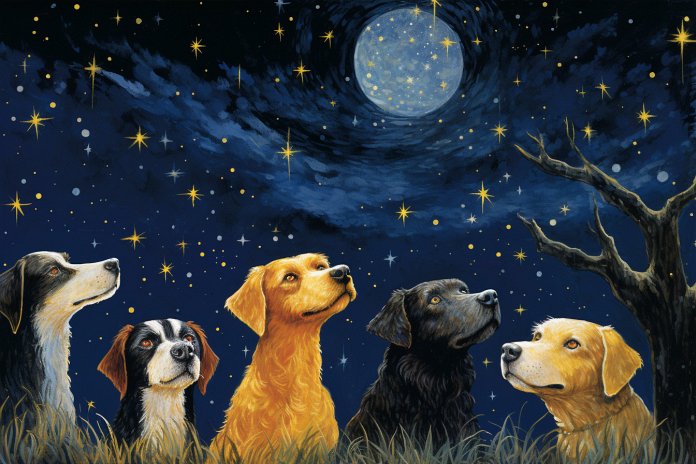
On a clear night, your dog may be fascinated by the sky. But can they actually see the details of the night sky? Dogs have different visual abilities than humans, with fewer color receptors and excellent night vision. In this article, we’ll explore the signs that dogs can see stars, their body language when observing the sky, the history of dogs and the night sky, and the science behind their visual abilities.
Signs That a Dog Can See Stars
When a dog is looking at the stars, they may display intense focus and alertness. They might also use their other senses, such as listening or sniffing, to better understand what they see. Dogs can provide audio cues or physical prompts to alert their owners to what they observe. However, some dogs may simply enjoy the view without investigating further, depending on their breed and age.
Body Language
Signs that indicate a dog can see stars include barking, whining, wagging their tail, sniffing, and raised ears. Other signs to watch for include looking up at night, coaxing their owner outside, and calmly laying outside.
The History of Dogs Seeing Stars
Dogs have a history of interacting with the night sky, particularly the moon. This association may be due to their shared ancestry with wolves. Dogs like Huskies, Alaskan Malamutes, and American Eskimo Dogs still retain some nocturnal instincts. As our understanding of canine behavior and physiology has evolved, we have learned more about why dogs are attracted to the night sky.
The Science of Dogs Seeing Stars
The ability to see is determined by cones and rods in the eyes. Dogs have two types of cones, which limits their color perception compared to humans. However, they have an advantage in night vision due to the tapetum lucidum in their eyes and larger pupils. While their vision is not as sharp as ours, dogs are less sensitive to light pollution.
Training Dogs to See the Stars
While you can’t change your dog’s physiology, you can encourage their curiosity about the night sky. Take them outside at night and allow them to gaze at the stars. This can be a calming experience for both of you. If your dog becomes overwhelmed or frightened, reassure them that they are safe. Gradual exposure to the night sky, with reassurance and comfort, can help them become more comfortable with it.
By understanding the signs that indicate a dog can see stars, their body language, the history of dogs and the night sky, and the science behind their visual abilities, you can better appreciate your dog’s fascination with the night sky and help them become stargazers.
“Guide your furry friend to become a stargazer and unlock their curiosity for the night sky.”

Tips & Things to Know
1️⃣ Dogs have different visual abilities than humans – Dogs have fewer color receptors and may be colorblind, but they have better night vision and a wider field of vision. Understanding their visual abilities can help you understand their behavior when looking at the night sky.
2️⃣ Signs that your dog can see stars – When a dog is looking at the stars, they may display behavior such as intense staring, raised ears, wagging tail, sniffing, and focused listening. They may also provide audio cues like whining, growling, or barking to get your attention. However, some dogs may simply enjoy the view without investigating further.
3️⃣ How to train your dog to be comfortable with the night sky – If your dog is overwhelmed or frightened by the night sky, gradually expose them to it while providing reassurance and comfort. Start with short outdoor exposure, reward good behavior, and gradually increase the time spent outside. With patience and positive reinforcement, your dog can become more comfortable with the night sky.
Frequently Asked Questions, Answered ✅
1. Can dogs see the night sky?
– Yes, dogs have excellent night vision and can see the night sky.
2. How can you tell if a dog is looking at the stars?
– Signs include intense staring, raised ears, and wagging tail.
3. What are some other behaviors dogs may exhibit when looking at the night sky?
– Dogs may sniff at the sky and provide audio cues like whining or barking.
4. Why are some dogs more attracted to the night sky than others?
– It depends on their breed and age, with some breeds being more naturally inquisitive and older dogs enjoying the quieter side of life.
5. Can dogs be trained to enjoy the night sky?
– Yes, by gradually exposing them to the night sky and providing reassurance and comfort, dogs can become more comfortable with it.